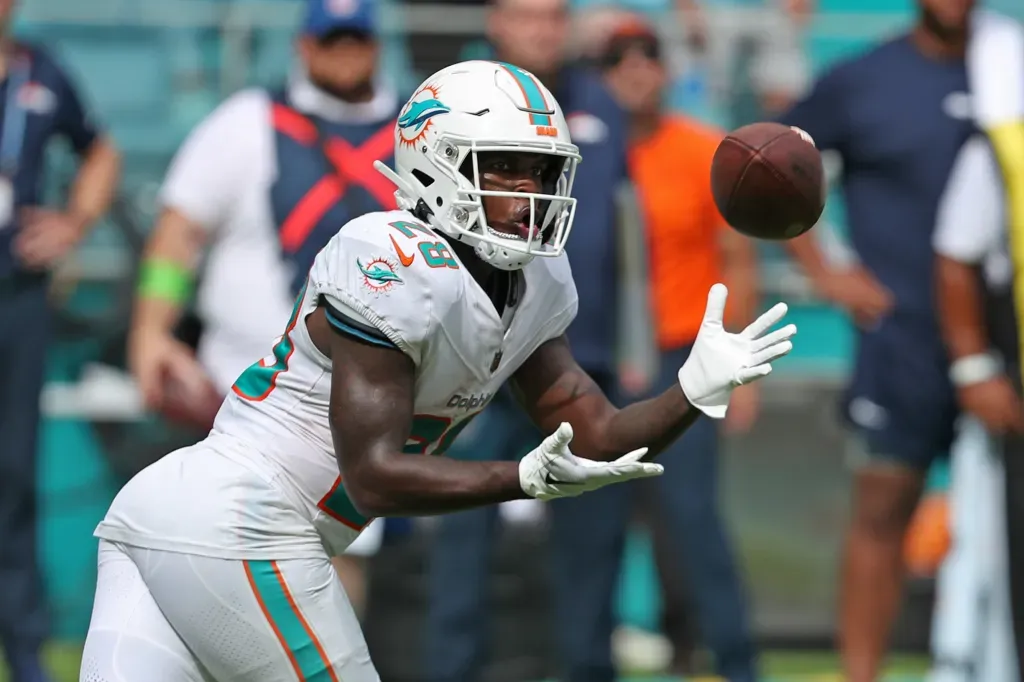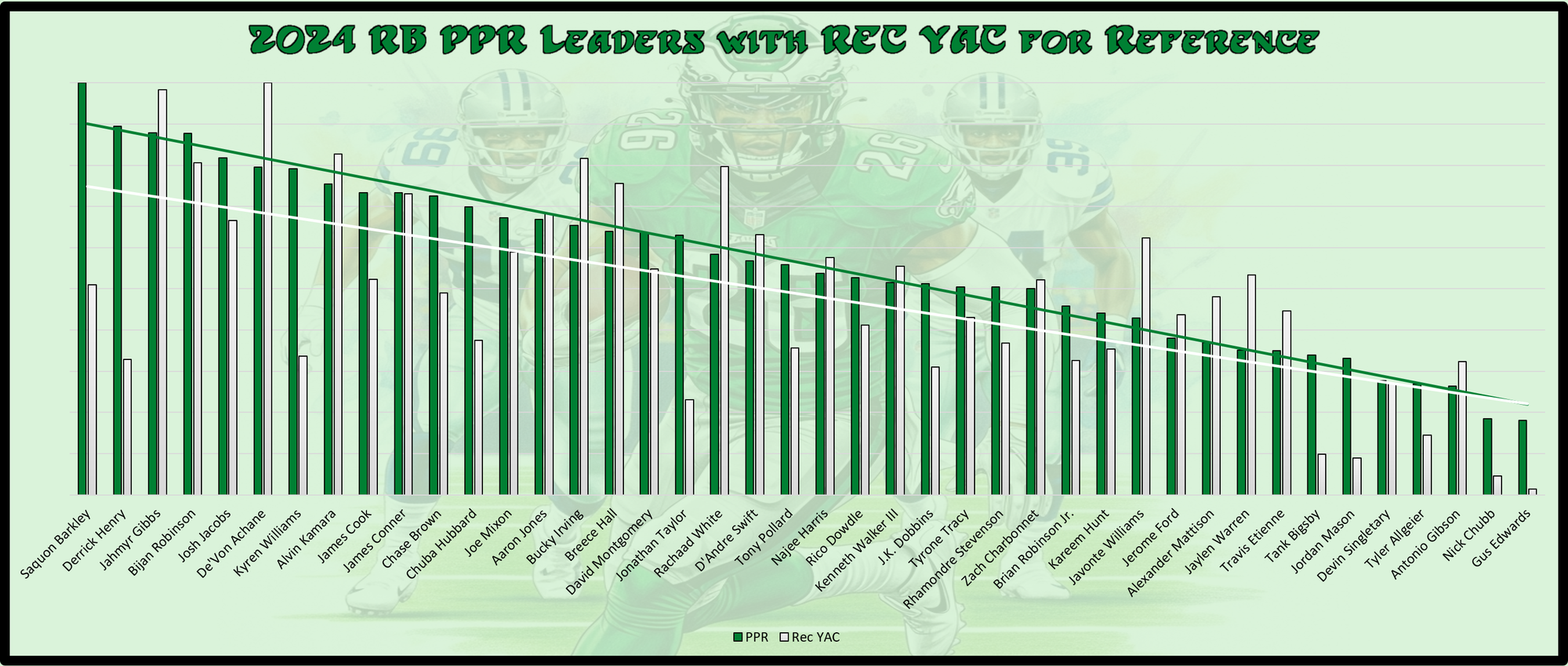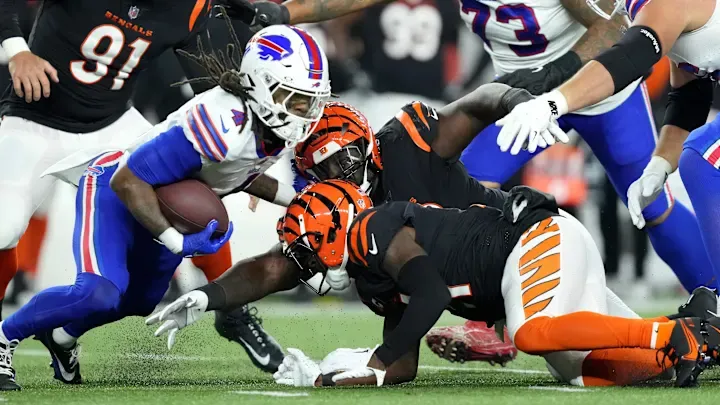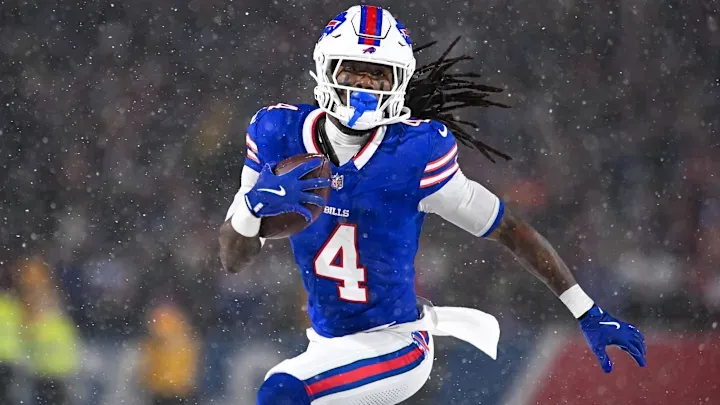
Overlooked Stats: Eight Running Backs Who Hold the Skeleton Key to Legendary Upside
In fantasy football, gaining an edge means going beyond rankings and uncovering predictive stats that go overlooked. Legacy stats like receptions, yards, and past PPR output are solid but are also low-hanging fruit. Every bushy-haired grandpa with a fantasy football magazine who enters your draft room uses these. That means they make poor tools for beating your league despite excellent signal.
The real advantage lies in digging deeper and identifying underutilized metrics that indicate future scoring spikes. The trick is spotting trends others miss—finding what actually predicts fantasy points before the rest of your league catches on.
PEARSON CORRELATION COEFFICIENTS
Pearson correlation coefficients are simple to calculate and measure the relationship between two variables, ranging from +1 to -1. With RBs in fantasy football, values over 0.3 indicate a more meaningful signal; over 0.4 is highly significant. With tools from sites like RotoViz, PFF, or Fantasy Points, it’s easy to export large datasets and run correlations on hundreds of stats in just a few days.
A five to ten-year window strikes the right balance, as it is modern enough to reflect today’s game but deep enough for a stable dataset. I filter out players with low usage or those who missed the following season and anchor to PPR + N1 to identify forward-looking stats. Still, these parameters can vary depending on how an individual analyst sets the variables.
Correlation has limits. Stats don’t always rank in the same order from study to study, but the general strength of a stat’s signal tends to persist. We should remember to focus less on the exact sequence of the correlations’ strengths and instead on whether a stat is consistently predictive from year to year.
Today, we’ll take a look at yards after catch among RBs.
YARDS AFTER CATCH AS A PREDICTIVE STAT FOR RUNNING BACKS
For this study, I reviewed 215 running back statistics sourced from RotoViz, PFF, Fantasy Points, ESPN, and NextGen Stats, spanning a ten-year sample, or as far back as each database allowed. I focused on correlations with next-year PPR performance (PPR + N1) to prioritize statistics with predictive value over descriptive value, as would be the case if we correlated them with the same-year outputs. A 100-carry minimum was applied.
Some metrics overlap across platforms—for example, rushing yards, rushing TDs, receiving yards, receiving TDs, and similar stats appear on multiple sites. These tend to correlate very closely with one another, so the idea that all 215 stats are entirely independent is somewhat misleading. However, I have chosen to include them in the analysis, as each platform collects and defines statistics differently, which can yield slight variations in the results.
Among the 215 stats tested, yards after catch (YAC) ranked as the fourth-strongest correlator for RBs to PPR + N1. YAC can be found on both PFF and RotoViz.

A FEW NOTES ABOUT RECEIVING STATS AMONG RUNNING BACKS
Generally speaking, correlation coefficients tend to transmit a weaker signal for RBs than for other positions. As mentioned, the strongest correlations for RBs barely exceed .400. However, for some positions, they can surpass .700. While this should make us cautious about overestimating the predictive power of these RB metrics, it still makes sense to prioritize the best indicators available. In other words, even if correlations offer less of an edge at the RB position, it’s still worthwhile to pursue whatever edges they offer.
The reasons behind this weaker predictability are not entirely clear; however, several contributing factors are likely to be at fault: RB performance is often more volatile due to team context, a higher likelihood of being scripted out of games, increased injury risk compared to other positions, and the fact that backups can often replicate a significant portion of a starter’s production. The same tenets that tell us to downplay our trust in RB metrics are essentially the same that serve as the foundation for the Zero RB strategy, which seeks to anchor to more predictive WR metrics and fade less predictive RB metrics.
Across the board, receiving stats tend to show stronger correlations with future RB performance than rushing metrics. Traditional receiving stats, such as receiving yards and receiving TDs, correlate better with success than their rushing counterparts. Similarly, receiving expected points (EP) often outperforms rushing EP as a predictor.
DON’T BARKLEY AND HENRY PROVE THAT RECEIVING METRICS AREN’T THAT CRUCIAL FOR RUNNING BACKS?
I’ll admit this all feels rather odd following a season dominated by two players who earned most of their fantasy production on the ground rather than through the air to finish first and second in fantasy scoring, as Saquon Barkley and Derrick Henry did in 2024 (Barkley can be an effective receiver, but the Eagles don’t use him that way). Most years, the top spot goes to a more involved pass-catcher, and the presence of two backs at the top who aren’t utilized in that way is unusual.
Marshall Faulk was ahead of his time. His pass-catching prowess, in an era when elite workhorse RBs weren’t typically used that way, gave him a massive edge in fantasy football in the late ’90s and early 2000s. It helped him finish as the overall RB1 a record three times. But as Faulk’s body broke down, the backs who followed didn’t necessarily see the same aggressive usage as receivers. The old guard more or less died with Shaun Alexander in 2005, ushering in a new era where nearly every RB1 to follow would be a strong pass-catcher. When we look at each RB1 since 2006, the relationship between fantasy scoring and YAC is apparent.

The 2024 version of Barkley is an outlier. Since 2006, only four overall RB1s have finished outside the top ten in YAC, including Jonathan Taylor, who finished 11th. Barkley in 2024 posted the lowest single-season YAC of any RB1 since 2012. Of the 19 RB1s since 2006, eight led the league in YAC, and 13 finished in the top three in the same year they were the RB1.
Meanwhile, most of the 2024 runners-up to the positional apex—Jahmyr Gibbs, Bijan Robinson, Josh Jacobs, De’Von Achane, and Alvin Kamara—were all featured heavily as receivers. 2024 is, frankly, an outlier, and passing-game usage remains one of the most reliable accelerants for an RB’s ascent to elite production.
DON’T FALL INTO THIS COMMON TRAP WHILE CONSIDERING PASSING GAME INVOLVEMENT AT RUNNING BACK
A common misconception is that this emphasis on receiving metrics is only relevant—or even just more relevant—in PPR formats.
In reality, the correlations remain consistent regardless. When correlating to PPR + N1, Half-PPR + N1, or Standard + N1, the differences are surprisingly minimal, if they exist at all. Recognizing this can be exploitable in standard-scoring leagues (if you can still find one).
Fantasy players often label backs as “PPR backs” or “non-PPR backs” based on their passing-game involvement, but in truth, the receiving work has broadly the same impact regardless of the scoring format.
YAC stands out as the most predictive receiving stat for RBs in this study, with a correlation coefficient of .421. Here are a few players whose 2024 excellence in this area suggests they might be slipping under the radar in 2025 drafts.
DE’VON ACHANE
- UNDERDOG ADP
- RB7
- 2024 YAC
- 661 YARDS (1ST in NFL)

De’Von Achane is one of the more vexing cases in fantasy this summer because the consensus seemed certain that he had been overworked in 2024 and was headed for a reduction in 2025. However, the Dolphins haven’t brought in significant competition (in with Alexander Mattison and Ollie Gordon, out with Raheem Mostert and Jeff Wilson, Jr.). Then, in some classic May/June news cycle ballyhoo, Dolphins’ HC Mike McDaniel said he envisioned a bigger role for Achane in 2025, and the fantasy community’s pulse collectively spiked (contextually, McDaniel may have meant a leadership role more than a physical role).
Part of the concern stems from Achane’s drop in efficiency; his fantasy points over expected (FPOE) was cut in half despite his EP rising by nearly five points per game. Even so, Achane’s FPOE was still excellent at 35.3 in 2025, seventh among RBs.
Achane’s work on the ground was somewhat pedestrian, but he still vaulted to an RB5 finish on the heels of his receiving work, finishing second in targets, first in receptions, receiving yards, and receiving TDs, and third in receiving market share. And, of course, he ranked first in YAC.
The biggest detractor for many is still Achane’s size. Though he is bigger than he was when he entered the NFL at 188 pounds, he is still among the smaller RBs in the league. It should be noted that many good RBs have played at a smaller size and handled big workloads, including Chris Johnson, his most common comparable, who missed just one game in his first seven seasons. If he can stay healthy, Achane is a threat to be the RB1 overall with a little TD luck, and could easily end up a value at his mid-second-round price tag.


